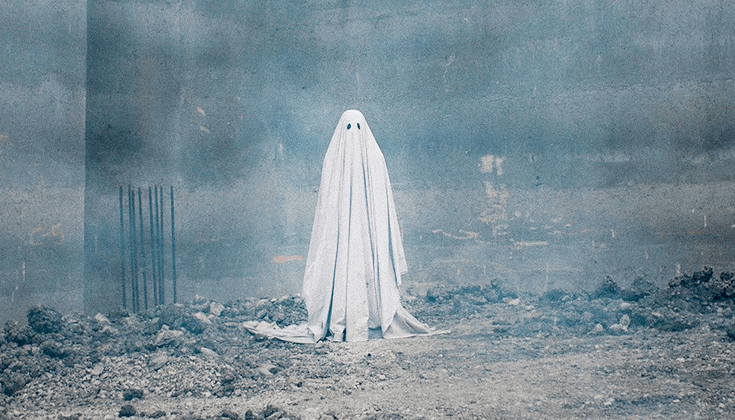A Ghost Story, a new indie film starring Casey Affleck and Rooney Mara, is a tender meditation on themes common to Buddhism, like impermanence and the bardo. Jennifer Keishin Armstrong reports.
A Ghost Story, a new indie film starring Casey Affleck and Rooney Mara, is a tender meditation on themes common to Buddhism, like impermanence and the bardo. Jennifer Keishin Armstrong reports.
A Ghost Story — a moody drama about a young husband haunting his widow — has one standout conceit that intentionally scrambles your emotions: the husband, played by Casey Affleck, does his haunting covered in a white bedsheet with eyeholes. It’s so absurd, when I saw the trailer, I had to laugh.
Aside from that, this beautifully shot indie film is deadly serious, enamored of themes like “life is precious and fleeting,” “we have only this moment,” and so on. Many of its central concerns have clear ties to Buddhist ideas of the afterlife and impermanence.
Writer-director David Lowery built a plot around his bedsheet ghost to tackle these themes, whether or not he meant the movie to be explicitly Buddhist. A Ghost Story is neither a thriller nor even an afterlife romance like the 1990 blockbuster Ghost. In it, Affleck’s nameless husband character dies in a car accident, then returns, covered in his white sheet from the morgue, to his home to watch his nameless widow (Rooney Mara) grieve. He lingers, and lingers, and lingers. He watches (as do we, unfortunately) as Mara eats an entire pie in a six-minute long scene. Eventually, she moves out, but he stays, obsessed with a note she left in a wall crack that he can’t reach. To avoid spoilers, I will just say that after that, we witness an astounding amount of more time passing, though not all of it is chronological.
An early screening of the film in New York City hosted by the Tibet House had some of the Tibetan practitioners present asking Lowery in a Q&A afterwards whether he was trying to evoke the concept of bardo with Affleck’s quest. Lowery demurred—skillfully—by saying that he had read a little about Buddhism and that he does meditate, but that his knowledge stops there. He hit upon the bardo idea—most broadly, the gap between death and rebirth—without knowing it. So it makes sense that his depiction doesn’t correlate directly with traditional bardo ideas, like lasting 49 days or experiencing visions related to one’s unskillful actions in life.
This afterlife journey takes on epic proportions, an indication that even the most ordinary among us have major karma to resolve, whether we want to admit it or not.
Ghost Affleck’s experience seems to last somewhere between 49 days and a kalpa—that is, an aeon, or a really long time, and mostly concerns his refusal to resolve his karma. Interestingly, he’s had a relatively ordinary life. He’s not depicted as having harmed anyone in a grand way. From what we see, he wasn’t a perfect husband, but he did okay. His was a small life, and yet his afterlife journey takes on epic proportions, an indication that even the most ordinary among us have major karma to resolve, whether we want to admit it or not. Unlike, say, Ghost—in which Patrick Swayze’s ghost character must specifically save his wife from imminent harm, and learn to express his love to her—Affleck’s mission isn’t clear, and his time frame isn’t fixed.
A Ghost Story obsesses over the reality that death means impermanence. But it doesn’t do this in a way you might expect, like through Mara’s character, who in fact exits the picture fairly early. And it doesn’t do this through Affleck’s character, who, after all, is dead but lingering in what seems like quite a bit of permanence. Instead, it does this mostly through speechifying that happens to take place in the house where Affleck is stuck. During a house party Affleck witnesses, a drunk guest in a sweat-stained T-shirt and overalls delivers what amounts to a dharma talk no one asked for. “You do what you can to stay around after you’re gone,” he says, citing artists like Beethoven as examples. He continues: “It’ll all go. … You can write a book, but the pages will burn.”
The film contains a related, better-executed thematic strand that has to do with the tyranny of memory—the refusal to see the emptiness of life that Buddhism makes its central tenet. Mara’s character attempts to hold onto life, in a sense, by writing down her memories and leaving them hidden in homes where she’s lived. She explains this at the beginning of the movie to set up the most important of those notes, the one she leaves behind at the house she shared with Affleck. That slip of paper, which apparently settles into the wall just beyond a sheeted finger’s reach, represents the film’s most interesting idea, the only one that isn’t overtly explained: She gives her memories a kind of permanence by writing them down, but she also leaves them behind without a second thought—without attachment. On the other hand, Ghost Affleck cannot let this one memory of hers go.
In another of the movie’s standout moments, he meets another ghost who can’t remember whom she’s waiting for, but she persists anyway. If we hold on too tightly to life, we can’t move forward, even, A Ghost Story says, in death.

